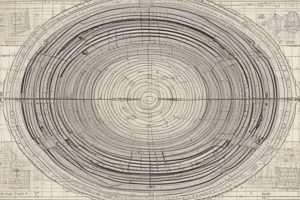Podcast
Questions and Answers
What is a characteristic of a scalar quantity?
What is a characteristic of a scalar quantity?
- It is only relevant in physical interactions.
- It can be completely described by a single value. (correct)
- It includes both magnitude and direction.
- It requires multiple values to describe it.
Which of the following is an example of a vector quantity?
Which of the following is an example of a vector quantity?
- Mass
- Distance
- Temperature
- Velocity (correct)
How is magnitude defined in the context of measurement?
How is magnitude defined in the context of measurement?
- It refers to the size or amount of a quantity. (correct)
- It is irrelevant in scalar quantities.
- It is the value without units.
- It describes the direction of a vector.
Which of these measurements would you classify as a scalar?
Which of these measurements would you classify as a scalar?
Why are vectors useful when giving directions?
Why are vectors useful when giving directions?
Flashcards
Scalar
Scalar
A quantity that can be fully described using only a single value, like temperature, which includes units of measurement.
Vector
Vector
A quantity that requires both magnitude (size/amount) and direction to be fully described, like giving directions.
Magnitude
Magnitude
The size or amount of a scalar or vector quantity. It always includes units of measurement.
Equilibrium
Equilibrium
Signup and view all the flashcards
Friction
Friction
Signup and view all the flashcards
Study Notes
Significant Number Rules
- All non-zero digits and zeros between non-zeros are significant
- Example: 300042 = 6 significant digits
- Leading zeros are not significant
- Example: 0.000034 = 2 significant digits
- Trailing zeros are significant if a decimal point is present
- Example: 0.0002500 = 4 significant digits
- Trailing zeros may or may not be significant if no decimal point is present; use the most conservative count
- Example: 190000 = 2 significant digits (could be up to 6)
Rules for Calculating with Significant Digits
- When adding or subtracting, round the result to the least number of decimal places.
- Example: 1.457 + 83.2 = 84.657 rounds to 84.7
- Example: 0.0367 - 0.004322 = 0.032378 rounds to 0.0324
- When multiplying or dividing, round the result to the least number of significant digits.
- Example: 4.36 x 0.00013 = 0.0005668 rounds to 0.00057
- Example: 12.300 / 0.0230 = 534.78261 rounds to 535
Practice Problems (Significant Digits)
- 43.74 km
- 4302.5 g
- 0.0083 s
- 1.200 x 103 kg
Chapter 5 Forces in Equilibrium
- 5.1 The Force Vector
- 5.2 Forces and Equilibrium
- 5.3 Friction
Types of Force
- Friction force
- Spring force
- Buoyant force
- Gravity force
- Drag force
- Applied force
- Electric force
- Magnetic force
- Normal force
Scalars and Vectors
- A scalar quantity has only magnitude (size/amount).
- Example: speed
- A vector quantity has both magnitude and direction.
- Example: weight
- Vectors are useful for describing directions.
Scalar Quantity
- A scalar is a quantity that can be fully described by its magnitude.
- Magnitude means the amount and measurement units are included.
- Example of scalar quantities include time, temperature, and length.
Vector Quantity
- A vector has both magnitude and direction.
- A single number is not descriptive enough for vector quantities.
- Example of vector quantities include displacement, velocity, and acceleration.
Studying That Suits You
Use AI to generate personalized quizzes and flashcards to suit your learning preferences.



